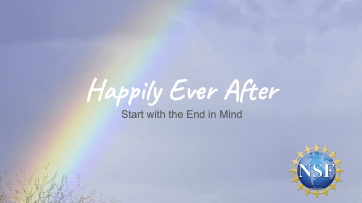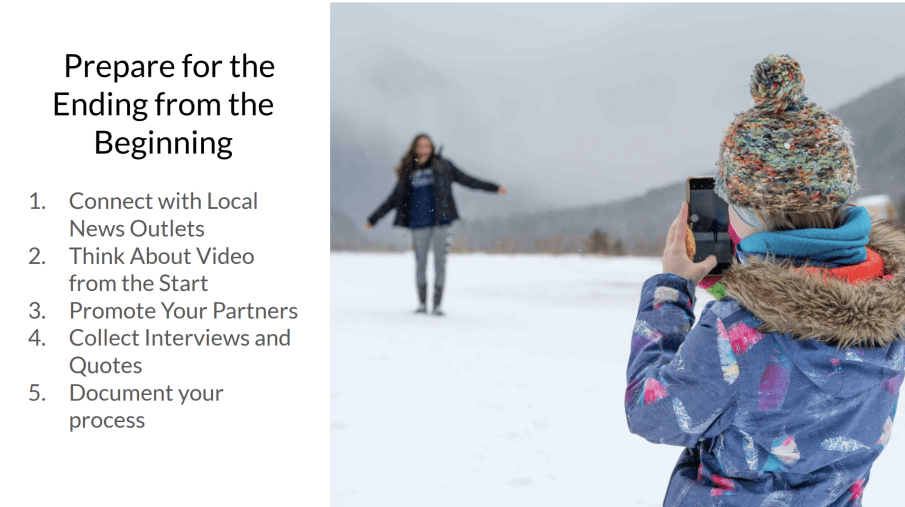Happily Ever After
Contributed by Martha Merson, Andee Rubin, Amanda Bastoni, Jessica Roberts
View the slides that were presented at the 2023 AISL Awardee Meeting.

Introduction
Most principal investigators (PIs) and their partners are highly committed to doing research that makes a difference in the world. Evaluators tell us how we are doing in the flow of the project and summarize the impact, but no one can predict the future. As PIs, we typically make our best determinations with the data we have, investing labor and time toward positioning findings for the greatest impact. Four PIs of AISL-funded projects offered ideas and questions at the 2023 AISL Awardee Meeting held in December, as well as their criteria for making decisions related to dissemination strategies, dissemination products, and continuity of research focus.
The four presenters created this session to address the questions:
- What are we doing now, during the funded phase of the project, to make a difference five years from now?
- How do we plan for the future?
For better and for worse, there is no single right answer. This means there is lots of room for creative approaches. On the other hand, we will never know if we got it exactly right.
Twenty-eight meeting attendees joined the presentation. They shared the following questions:
- How does one support any technology used after the end of the project?
- How can PIs ensure that resources will be used after a few years?
- How does one ensure that a museum exhibit has a life beyond the 3-5 year grant?
- How to plan for a project ending while aspects of the work or collaboration will continue?
- How have others spent grant funds at the tail end of a project in ways that are purposeful?
- How to avoid leaving a partner in a lurch?
- How have others shared the project outcomes with the learner participants?
- Any suggestions for making time to write up findings for publication while data collection may be ongoing?
- Where does one find the time for writing articles and distilling findings?
Presenters
Andee Rubin is a data scientist, mathematician, and senior scientist at TERC. She has led several projects that brought together math educators and informal science professionals to identify and highlight the math in museums, zoos and aquariums.. Andee brought an artifact of a past project to share as an example of a dissemination strategy. Math Momentum in Science Centers is a collection of case studies of science centers incorporating mathematics into their programs and exhibits; the book has been distributed free. She described it as a way to leave behind an impact even when a project is over.
Amanda Bastoni is the Director of Career, Technical & Adult Education at CAST which popularized universal design for learning. She co-leads a STEM Pathways grant that ended in January 2024. This project paid rural students as co-researchers to investigate the presence of STEM in their outdoor recreation activities. The project looked at outdoor recreation as a lever to help STEM learning/identity. Bastoni and partners are proud of the high retention in the study and pleased with the impact of hyper-local dissemination through small town newspapers. Amanda is also a member of the Rural Catalyst Group and she is the PI on another rural focused project.
Martha Merson is a Project Director at TERC who worked with National Park Service interpreters for several years on science communication. She is currently working with environmental educators and others on how soundscapes affect learning among visitors to informal science learning venues. She previously worked with environmental organizers using environmental data with community groups, including Public Lab, a non-profit dedicated to democratizing science to address environmental issues found materials online made possible from an earlier project, Statistics for Action. Public Lab re-skinned and circulated materials that were dormant after Statistics for Action wound down.
Jessica Roberts is an Assistant Professor at the School of Interactive Computing, Georgia Tech. Jessica is involved in three AISL projects, one in its beginning phase, one in the middle, and one wrapping up. Jessica and the team are wondering how to continue their research on Accessible Oceans as the pilot and feasibility grant concludes. PI Amy Bower, a blind ocean researcher, has used multiple strategies to make sense of data that others analyze with visual methods. The project will be able to disseminate to a diverse audience because making sonographic versions of datasets is of interest to professionals such as sound engineers, oceanographers, learning scientists, exhibit designers, Association for Computing Machinery members).
Who needs to know?
Martha quoted Congressional representative Ayanna Pressley: “People close to the pain need to be close to the solutions.” For example, she noted that front line workers in the National Park Service (the interpretive rangers who staff visitor desks, help with way-finding, and lead walks and talks) were her major first and primary audience. However, they couldn’t be the sole focus since they are not in positions of power to enact recommendations. For instance, they are not setting up professional development workshops with scientists. Martha’s project had to design multiple products to reach audiences including front line interpreters, their supervisors, scientists, and others.

Tips from presenters and participants
Consider: Where is your audience already? Who is in a position to act on your findings?
- Think about nonprofit partners with large mailing lists (e.g., Sierra Club) that could find a hook and help with dissemination.
- Leverage a partner’s social media if they already are a community resource and have a following. Projects don’t have to create something new and spend energy directing traffic to it.
- What outlets serve your audience? Journal articles tend to be privileged over other vehicles, but they do not reach public audiences.
- Publish materials in multiple languages to reach more parents and educators.
- Talk with policy experts and policy makers who can help with large-scale adoption of findings (for example, contact the education policy people at UNESCO)
How will they [practitioners and the public] remember? What do we leave behind?
Andee recommended connecting with practitioners from the beginning about what they would want to know and find useful from the project. “Think about the stories of practitioners and participants, and how THEIR stories can be useful if shared.” Amanda recommended making presentations at local and practitioner focused conferences and adding QR codes to slide decks for ease of sharing and as an accessibility feature.
Tips
- Think about lessons learned. What should someone who tries to follow up on your work know? What might save them time and effort?
- Make products accessible! (e.g., free to download; different versions or accommodations for people with disabilities)
- Create a vehicle and context for products (such as professional development workshops that feature a guide or new approach your project generated or tested)
- Engage artists! Work with artists to add sound or visuals that enhance products and bring a multisensory dimension to dissemination.
- Create products that are practical. Consider how and when informal educators adopts new practices and gear products for those applications. Take time to design products so they are intuitive to use.
- Create a version of the findings that gets to the point and is concise.
Prepare for the end from the beginning
Amanda and Jessica both shared recommendations for building interest and a following for the project. Amanda recommended connecting with local news outlets. She also encouraged thinking about creating videos from the start with participant consent. Jessica has found that a project blog is a great way to show the process and thinking that goes into a project. Blogging websites such as Wordpress are not as heavy a lift as you might think.
Tips
- Promote your partners (who will then mention you)
- Collect interviews and quotes
- Document your process
- Include funds in your budget to work with a web developer
- Include funds in your budget for a writer. You might hire a student with design skills who would bring a sensibility that will appeal to younger audiences
- Plan ahead–take time to explore how evaluation and research data collection could inform dissemination
Next Steps
In this session participants recorded questions, and dilemmas as well as wins related to dissemination and the final phase of an AISL project. The session conveners shared these with the REVISE team as fodder for future sessions (online or at the next AISL PI meeting).
Andee recognized that participants had questions about IRB in response to the suggestion of collecting quotes and photos. She suggested looking for a session on satisfying IRB concerns and ways PIs can manage data sharing in a future meeting.